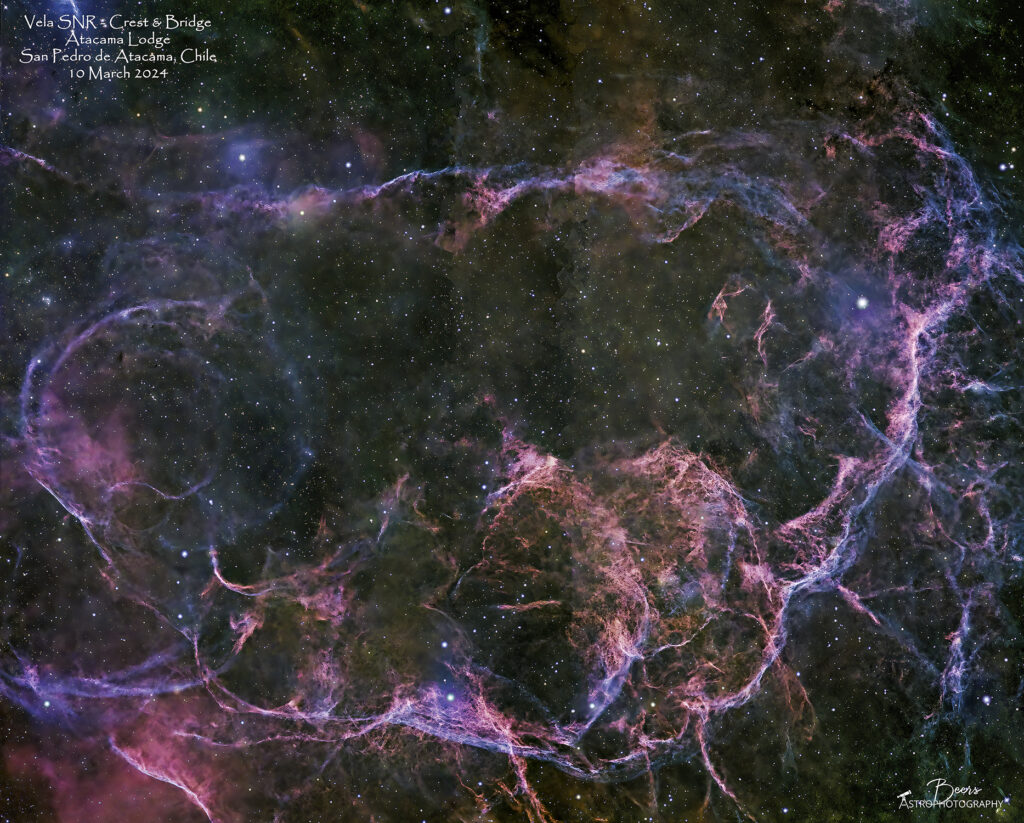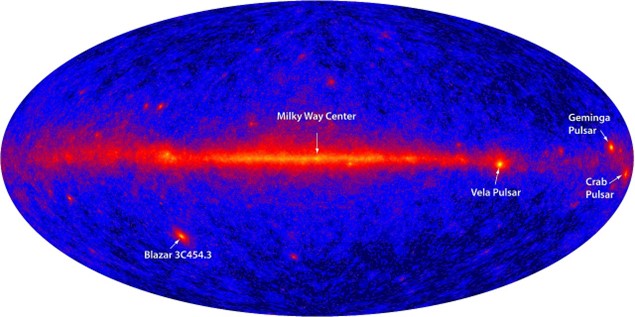
Fun facts
The Vela supernova remnant is a supernova remnant in the southern constellation Vela. Its source Type II supernova exploded approximately 11,000 years ago (and was about 900 light-years away). The association of the Vela supernova remnant with the Vela pulsar, made by astronomers at the University of Sydney in 1968, was direct observational evidence that supernovae form neutron stars.
The Vela supernova remnant is one of the closest known to us. The Geminga pulsar is closer (and also resulted from a supernova), and in 1998 another near-Earth supernova remnant was discovered, RX J0852.0-4622, which from our point of view appears to be contained in the southeastern part of the Vela remnant. This remnant was not seen earlier because when viewed in most wavelengths, it is lost in the Vela remnant.

Distance: ~936 light years
Apparent Magnitude: 12
Apparent Dimensions: 8 degrees (approximately
Constellation: Vela
Designations: Vela XYZ, Gum 16, SNR G263.9-03.3, 1E 0840.0-4430, RE J083854-430902
{ From: https://en.wikipedia.org/wiki/Vela_Supernova_Remnant }
The book, Imaging the Southern Sky by Stephen Chadwick & Ian Cooper (an EXCELLENT reference that I used to plan all my targets for this trip) describes the Vela Supernova Remnant on pp 34-54, including an overall image and reference chart shown below.


- Gum20
- Crest and the Bridge
- Twin Crescents and the Bypass
- Highway and the Spur
- Pencil Nebula
- Spiral Flame Nebula
The reference chart describes portions of the Vela SNR. After processing my capture that I planned as a capture of #2. Crest and the Bridge, it looks as if it is really more of a combination of #2, 3, and 4 and some of the gap area in-between those “named” targets. I already have started building my list of desired targets for a 2025 Atacama Lodge trip. As Stephen Chadwick and Ian Cooper, the Imaging the Southern Sky authors describe, I will be spending some imaging time on this “astroimager’s paradise!”
Capture & Processing Notes
On night #5 of the Atacama Desert trip, I imaged a two-tile image of the Vela SNR Crest & Bridge from sunset until it set at 0400. Then switched to (what I’m calling) the Carina group (Keyhole, Banana, Whirling Dervish, Gabriel Mistral) from 0400 until sunrise at 0645.
The only issue I encountered was during the meridian flip. For the first time, the time of the meridian in SGP was exactly at the time of the meridian flip as opposed to 20 minutes past, that I’m accustomed to and had been showing since I turned off the auto meridian flip earlier in the trip when I was having issues with it. As a result, I got up and outside (and Danita joined me!) at exactly the meridian flip time. When I attempted the flip, the telescope returned to the west side of the pier. I terminated the sequence, rebooted everything and waited until about 8 minutes after the meridian, then the flip worked fine.
I got up to check the switch between the two tiles – that as usual, went smoothly. Although in processing, they were slightly misaligned requiring a cropping of some of the edges. There was also a noticeable seam between the two tiles – definitely cause for recapture (and perhaps processing and posting the individual tiles, when time allows).
Sequence Plan:
- Sequence plan: Two-tile mosaic.
- Tile#1: Captured 38x5min, Total time = 190min, 3:10 hrs. Captured 10Mar2024, 2101CDT – 11Mar2024, 0044CDT
- Tile#2: Captured 36x5min, Total time = 180min, 3:00 hrs. Captured 11Mar2024, 0045CDT – 11Mar2024, 0401CDT
- Captured: Night of 10 March 2024 (10Mar2024, 2101CDT – 11Mar2024, 0401CDT);
- Shooting location: Atacama Lodge, San Pedro de Atacama, Chile
Processing summary: Captured with SGP. Stacked in APP. Star removal with Starnet++. Processed in LR/PS
Equipment
All equipment controlled by HP Probook (DSO CTRL 1) Windows 10 laptop running Sequence Generator Pro v4.3.0.1305.
- Polar alignment: QHYCCD camera (controlled by Polemaster for polar alignment)
- Imaging: (Southern Cross) Askar FRA600 on Rainbow Astro RC-135E, ZWO ASI2400MC#1 camera
- Autofocuser: ZWO EAF ( Electronic Automatic Focuser)
- Mount: Rainbow Astro RST-135E (controlled by iHubo ASCOM driver)
- Autoguiding: Orion 60mm Multi-Use Guide Scope with Orion StarShoot AutoGuider Pro Mono Astrophotography Camera (controlled by PHD2)
